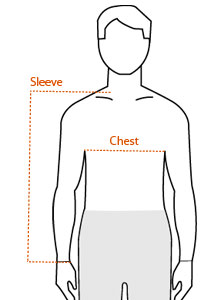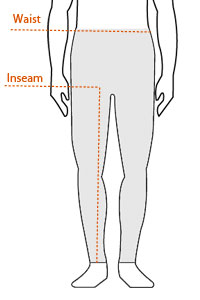
-

Just like building a house, you’ll need to start with the foundation first. When that's finished, you're free to build upon that piece by piece. We've broken down the most important components below, so you'll know what to put at the top of your list. Remember, dress clothing isn't meant to fit like your favorite, worn-out T-shirt. It should have a fitted yet comfortable feel. Knowing your size is essential. To start, you’ll need to either measure yourself according to our guidelines below or get measured by a tailor.
Get the Best Suit for Your Buck
Price tags on dress clothing can be overwhelming, especially if you're just starting out. Keep in mind, though, that a quality suit should last a very long time. It will also fit, look and feel better than a less expensive suit. Better to have one really great suit than two or three inexpensive ones that won’t hold up well and won’t look as sharp.
The Foundational Men's Wardrobe
There are a lot of different options out there, but some choices are always in style. Consider choosing these seven staples to get you started. You can always add more later.
- Suit: Black or dark charcoal fabric, single breasted, with either two or three buttons. Three-season wool is the most versatile.
- Solid navy blazer: Two buttons.
- Dress pants: Wool gabardine in dark charcoal.
- Shirt: White with a spread collar (not a button-down collar).
- Tie: Medium-width in a solid color.
- Belt: Black leather with a silver buckle.
- Shoes: Black leather. Consider going with a classic oxford or derby.
-

The suit is an essential element to looking your best in any semi-formal situation. As a rule, more expensive suits incorporate more handwork, which equals longer life and a more sophisticated, natural drape. No buts about it, you should make your first suit a dark one. Charcoal gray is an acceptable choice, but black and navy suits are the most versatile. A single-breasted suit in three-season wool is ideal, as it can be worn for almost any occasion.
How to Measure Yourself For a Suit Jacket
Although many men find it easier to have a tailor take their measurements, it's not rocket science. You can easily do it at home by yourself or with the help of a friend. All you’ll need is a tailor’s measuring tape, which is available for a few dollars at any fabric store or online.

Suit Jacket Size
Suit jacket size is determined by your chest measurement. Start at the fullest part of your chest and wrap the measuring tape under your arms and around your back until you return to the starting point. A size 42 suit jacket should fit if your chest measurement is 42".
If you're in the middle of two sizes, always round up. A tailor can take a suit in if it’s too large, but he can’t add fabric. If it's too small, you're out of luck. Don't worry if the sleeves are too long or too short. Sleeve length is an easy and affordable alteration. Your suit pants will also need to be hemmed by a tailor or seamstress.
Suit Pants
When purchasing a full suit, the pants will almost always come unhemmed, with an inseam of 38". They'll need to be hemmed by your local tailor or seamstress. Most suit pants have a 6" drop, which means that the waist of the pants is 6" less than the size of the jacket. For example, a size 40 jacket will come with pants that have a 34" waist. The waist size can generally be taken in or let out by 2" for a custom fit.
Tips to Suit Yourself
- It’s usually a good idea to stick with single-breasted suits as you initially build your wardrobe. Many men will never need a double-breasted suit, which is geared toward more formal occasions. Of course, if you have several suits already, a double-breasted suit is a classic.
- Never button the bottom button! Only button the top one or two buttons on your jacket, never the bottom one. That's just the way it is.
- To avoid bulging pockets, simply don't open them (most suits will come with their pockets sewn shut).
- Jacket sleeves should rest at the break in your wrist and reveal a half inch of your shirt cuff.
- Pleated pants or flat front pants? This is strictly personal preference. Go with what you like or what suits your physique best. If you like a more contemporary, trim look, you’ll probably prefer flat front. Pleats, on the other hand, offer a little extra room when sitting down.
- When having your pleated pants altered, you'll want the hems to be cuffed. Flat front pants should have un-cuffed hems. Most tailors should be aware of this, but it never hurts to ask.
- Two-button or three-button jacket? Two-button jackets have a more traditional look, but both styles are common these days. Just remember to leave the bottom button undone when wearing either style.
- Center vent or side vents? Again, this is up to you. A suit jacket with a center is a classic style. Side vents are a little more modern.
- Vents will usually come sewn together by a thread. Don't forget to cut this thread (carefully) before you wear your suit for the first time.
- If it doesn't feel comfortable, it probably doesn't look comfortable either. You want to be able to pick up your pen, shake hands, type a memo, reach for the phone and dip your dancing partner. But there's a fine line here. Remember, your suit is a fitted wardrobe piece. If your suit is too large or baggy, it won’t look right.
- Maintain your suit by always hanging it in a garment bag in your closet. Always hang it on a hanger that is designed to hold a suit. Leave the jacket unbuttoned to avoid stressing the threads.
-

Versatile and classic, the blazer is an essential element in your new dress wardrobe. A great go-to jacket, a blazer can easily be dressed up or down depending on the occasion. Keep in mind that if you have a navy suit, the jacket of that suit can double as a navy blazer.
- Blazer vs. Sport Coat: The only difference between a blazer and a sport coat is that a blazer is always solid-colored and a sport coat always has some type of pattern (stripes, checks, herringbone, etc.).
- Dress it up by wearing it with a tie and wool gabardine dress pants. This handsome look is nearly as formal as a suit.
- Dress it down by wearing it with khakis or a nice pair of dark jeans. Match your blazer or sport coat with a sport shirt or polo shirt for a casual (but not too casual) look.
- Whether you're pairing your blazer with dress pants, khakis or blue jeans, adding a white pocket square adds instant elegance and refinement to your look.
Blazer and Sport Coat Size
Blazer and sport coat sizes are determined by your chest measurement. This means your blazer size will be the same as your suit jacket size, and visa versa. Just like a suit, your blazer or sport coat may require some alterations.
-

There are quite a few options when it comes to choosing dress shirts to go with a suit or blazer. In this guide, we’ll start with the most versatile and important shirt, and expand from there.
Choosing Colors
White First
A freshly pressed white dress shirt with a spread collar (not a button-down collar) is always appropriate and sends the signal that you're efficient and neat. Also, a white dress shirt will pair nicely with almost any suit, blazer or sport coat. It will also pair with most ties.
Blue Second
A medium blue dress shirt with a spread collar is another classic option, and nearly as versatile as a white shirt. Although a blue shirt is a little less traditional than white, it is still very sharp.
Beyond White and Blue
If you already have a white and a blue shirt, classic stripes and checks on a white background are an excellent next step. For a slightly more casual look, you can pair a button-down sport shirt with your blazer or sport coat, without a tie. Just make sure to leave the top button of your shirt undone.

Dress Shirt Tips
Keep It Clean
Make sure your shirt is always crisp, clean and pressed. A rumpled shirt signals a disheveled lifestyle.
Don't Sweat It
Wear a plain white T-shirt or sleeveless A-shirt under your dress shirt. This can help absorb any excess perspiration.
Cuffs and Collars
You'll want to stick with a spread collar and button cuffs to wear with a suit. Don't wear a shirt with a button-down collar under your suit. French Cuffs can add style, but are generally more formal.
How to Measure Yourself For a Dress Shirt
A fine dress shirt should fit like it was made especially for you. To get this look, you'll buy according to your neck size and sleeve length. High-quality dress shirts don't come in small, medium and large.

Neck Size
Start at the Adam's apple and wrap the measuring tape around your neck, being careful not to twist or pull it too tight. There should be no space between the neck and the tape. The measured number is your actual neck size. Simply add a quarter to a half an inch to the actual neck size to get the dress shirt neck size. You'll want to be able to snugly fit two fingers between your neck and the collar of your dress shirt.
Sleeve Length
With your arm relaxed at side and elbow slightly bent, measure from center back of neck, over point of shoulder, and down outside of arm past elbow to wrist.
Quick Tip: It's much easier to have someone help you take shirt measurements, as the sleeves can be a little tricky to measure on your own.
-

A nice pair of dress pants will come in handy for many situations. Although your suit pants can double as dress pants in a pinch, remember that pants wear out faster than jackets. For this reason, you’ll want to buy a separate pair of dress pants or slacks to wear with your blazer or sport coat. Wool gabardine dress pants in dark charcoal are an all-around excellent choice. Charcoal is the most versatile color for dress pants. Wool gabardine is comfortable, durable and attractive fabric. In the colder months, you may prefer to wear wool flannels. This is similar to wool gabardine, but warmer.
Quick Tip: Most dress pants can be brought in or let out 2" at the waist.
Hems
The general rule here is that pleated pants should have cuffed hems and flat front pants should not. The hem should break slightly on the top of the foot and be slightly longer in back.
Belts and Shoes
Don't forget the belt. This is crucial. A black leather belt is the most versatile, but should always match your shoes. If you’re wearing brown shoes, you’ll need to wear a brown belt. We’ll cover this in more detail near the end of the guide.

How to Measure Yourself for Dress Pants
You'll need to know your waist and inseam measurements when purchasing dress pants.

Waist
Be sure to measure at your belt line or natural waist. Simply bend to the side and note where your body creases. Dress pants shouldn't ride low on the hips like some casual pants do.
Inseam
Measure your entire leg, from crotch to arch of the foot.
Quick Tip: It's always better to go with a longer inseam than a shorter one, so round up. A tailor can easily take pants up, but they won’t be able to make them longer.
-

Finally, the finishing touch -- the piece that "ties" your whole look together. No dress wardrobe is complete without at least one tie. You'll want a subtle tie for business, but social events present the perfect opportunity for creative expression. Go with a medium-width tie that's 3½" across at its widest point for the most versatility. If it's too skinny or too wide, you limit the types of shirts you can wear it with.
How to Tie Your Tie
It's not much trickier than tying your shoe, once you get the hang of it. The most popular way to tie a tie is the four-in-hand knot with dimple. Check out the video below for a simple tutorial:
Tie Tips
- Once you have it on, the tip of your tie should touch the top of your belt buckle.
- Take care of your tie by removing it the same way you tied it, in reverse. A silk tie cannot be washed or pressed, so proper care is essential.
- When storing ties in a closet or drawer, always roll them. Folding will crease your ties, and hanging silk ties can destroy their shape over time.
-

The first pair of dress shoes you should probably buy are polished black leather oxfords (lace-ups). Combined with a black belt, these shoes will pair with almost anything in your dress wardrobe. If you buy a second pair, go with medium brown or dark brown oxfords. Of course, if you’re a little more adventurous, you can always add character to your look with a set of bluchers, wingtips or brogues. If you’re really looking to grab some attention, a pair of monk strap shoes can make a statement. Just make sure the buckle on your shoes matches the buckle on your belt (i.e. silver or brass). Finally, for a more casual look and travel, leather loafers are comfortable and make getting through airport security much easier.
How to Clean Your Dress Shoes
Dirty dress shoes are just as shabby looking as a wrinkled shirt. It’s important to clean your leather dress shoes if they become dirty. Use a soft, damp cloth to wipe away dirt and mud, then wipe them dry with a clean cloth. Be sure to get under the laces. If your shoes get really dirty, you may need to remove the laces before you clean them. For dirty soles, you can use a soft, dry toothbrush to scrub away any dirt in the treads and other gaps. If you wear dress shoes to work, consider keeping a rag in a drawer so you can wipe them off at the office, should they get dirty during the commute.
If your shoes are scuffed, you’ll need to apply an appropriate color of shoe polish to touch them up. Clean them thoroughly first. Then use a section of old T-shirt or a soft rag to apply a small amount of polish. Rub in a circular motion and wipe away any excess. Finally, use a horsehair brush to buff them to a shine. It’s a good idea to lay down some newspaper, so that you don’t get polish on your floor.